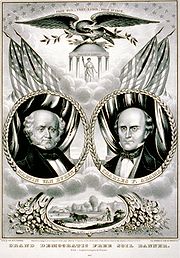
Back حزب الأرض الحرة Arabic Strana svobodné půdy Czech Free Soil Danish Free Soil Party German Free Soil Party Esperanto Partido del Suelo Libre Spanish حزب خاک آزاد Persian Free Soil Party Finnish Parti du sol libre French Free Soil Party Italian
Free Soil Party | |
|---|---|
 Martin Van Buren/Charles Francis Adams campaign banner | |
| Leader | |
| Founded | 1848 |
| Dissolved | 1854 |
| Merger of | |
| Split from | Liberty Party |
| Merged into | Republican Party |
| Headquarters | Buffalo, New York |
| Newspaper | Free Soil Banner |
| Ideology | Anti-slavery[a] |
| Slogan | "Free Soil, Free Labor, Free Men"[1][2] |
The Free Soil Party was a short-lived coalition political party in the United States active from 1848 to 1854, when it merged into the Republican Party. The party was largely focused on the single issue of opposing the expansion of slavery into the western territories of the United States.
The Free Soil Party formed during the 1848 presidential election, which took place in the aftermath of the Mexican–American War and debates over the extension of slavery into the Mexican Cession. After the Whig Party and the Democratic Party nominated presidential candidates who were unwilling to rule out the extension of slavery into the Mexican Cession, anti-slavery Democrats and Whigs joined with members of the abolitionist Liberty Party to form the new Free Soil Party. Running as the Free Soil presidential candidate, former President Martin Van Buren won 10.1 percent of the popular vote, the strongest popular vote performance by a third party up to that point in U.S. history.
Though Van Buren and many other Free Soil supporters rejoined the Democrats or the Whigs immediately after the 1848 election, Free Soilers retained a presence in Congress over the next six years. Led by individuals like Salmon P. Chase of Ohio, John P. Hale of New Hampshire, and Charles Sumner of Massachusetts, the Free Soilers strongly opposed the Compromise of 1850, which temporarily settled the issue of slavery in the Mexican Cession. Hale ran as the party's presidential candidate in the 1852 presidential election, taking just under five percent of the vote. The 1854 Kansas–Nebraska Act repealed the long-standing Missouri Compromise and outraged many Northerners, contributing to the collapse of the Whigs and spurring the creation of a new, broad-based anti-slavery party known as the Republican Party. Most Free Soilers joined the Republican Party, which emerged as the dominant political party in the United States in the subsequent Third Party System (1856–1894).
Cite error: There are <ref group=lower-alpha> tags or {{efn}} templates on this page, but the references will not show without a {{reflist|group=lower-alpha}} template or {{notelist}} template (see the help page).
- ^ Foner, Eric (April 20, 1995). Free Soil, Free Labor, Free Men: The Ideology of the Republican Party before the Civil War. Oxford University Press. ISBN 9780195094978.
- ^ Ohio History Central. "Free Soil Party". Ohio History Connection. Retrieved August 3, 2017.
© MMXXIII Rich X Search. We shall prevail. All rights reserved. Rich X Search